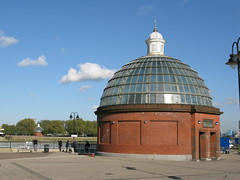Last week, when I went to look round the part of the Naval College that Greenwich Hospital wants to cover with a temporary market, an actual rather than a potential eyesore sprung into view. What on earth is happening with Greenwich Pier?
Readers with very long memories may recall that planning permission for three new pier pavilions was granted by Greenwich Council in February 2007, two and a half years ago. The pier’s old wooden buildings were swiftly knocked down – but since then, nothing.
No sign yet of the “resolutely modern” development, incorporating new boat ticket offices, toilets and three cafe/bar-restaurants, that we were promised. (Not sure whether that’s a good or a bad thing – from the artists’ impressions, it looks pretty ugly.) There is currently no shelter at all on the pier, and a lot of wooden hoardings; tickets are sold from temporary portacabin-like buildings on the shore. The whole place is incredibly confusing to many pier users and is also, frankly, a mess.
The news I bring you – you heard it here first – is that the development of the new pier is finally supposed to begin soon. Edward Dolby, resources director of Greenwich Hospital, which co-owns the land to be built on, said: “It is my understanding that the work will start in the autumn. It has been a long-drawn-out process getting all the legal agreements sorted out. The devil is in the detail – there are something like 17 documents.”
The problem with the pier area is that it has at least four owners. London River Services, part of TfL, owns the pontoon – that is, the bit that actually floats on the water, and alongside which the boats pull up. The Hospital and the Port of London Authority jointly own the promenade – the bit on dry land between the river and the boundary railings of the pier area, where the new buildings will fo.
Greenwich Council owns the pavement outside, which everyone must cross to reach the pier. To complicate this classic British muddle, the actual development is being built by yet a fifth party – the developer Stonehurst. And then the boats themselves are operated mainly by sixth and seventh parties – City Cruises, for tourists, and Thames Clippers, the high-speed commuter service.
You may not be wholly astonished to learn that the council has been one of the major holdups. According to one source involved with the project, “the developer is spitting feathers because he says he’s got the money but he’s had delays with the council in the final planning stuff that he felt was unnecessary.” You’d think that the council would have considered these issues before it gave planning permission – but apparently not.
I couldn’t confirm my information either with the council (its press office number was permanently engaged this afternoon) or with the developer (its number simply rang out, and its PR’s mobile and landline have been disconnected.) Let’s hope that in the current deeply hostile economic climate for development, the delays have not seen the money vanish and killed the project off.
If things do get under way, there is still the risk of massive disruption to the Thames Clippers service, which has seen a gigantic rise in passengers over the past two years and is becoming a real public transport alternative for Greenwich. The pier is not intended to close completely, but Sean Collins, the head of Thames Clippers, says that its capacity is likely to be seriously reduced.
“I am very disappointed with the lack of communication between the council, the PLA and London River Services,” says Collins. “Access could be severely disrupted and it doesn’t appear that they are joined up on it.” The pier redevelopment will cut right through the river’s summer 2010 season and may also touch summer 2011, Collins says. There is no plan yet in place for how the pier will cope with its current boat traffic when it becomes a building site.
One other thought occurs. The delay to the pier redevelopment means that it really starts to clash with several of Greenwich’s other pet development projects. The timings are now extremely difficult.
If planning permission is granted for the temporary market on the Naval College, the traders will load and unload on the eastern side of the Cutty Sark – and construction traffic will use it, too. But that same space will be needed – at the same time – for construction traffic on the pier.
The pier project also clashes with Greenwich Council’s absurd plans to close and tart up the foot tunnel. The council is investigating an alternative ferry service for cyclists. But if the pier’s capacity is reduced, it seems most unlikely that there will be room for a replacement ferry.
I’ve written before about the danger that the whole of central Greenwich is about to become a building site. But what I hadn’t realised until now is that the town centre may simply not be big enough to fit all the various schemes in. We seem to be faced with that most difficult of combinations – a council whose grandiose plans are not matched by the reality of its planning and co-ordination skills.

